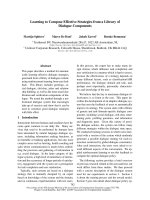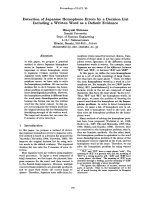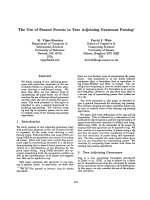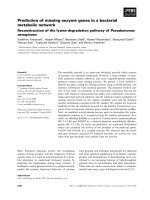Báo cáo khoa học: "HOW TO DETECT GRAMMATICAL ERRORS IN A TEXT WITHOUT PARSING IT" doc
Bạn đang xem bản rút gọn của tài liệu. Xem và tải ngay bản đầy đủ của tài liệu tại đây (670.7 KB, 8 trang )
HOW TO DETECT GRAMMATICAL ERRORS IN A TEXT WITHOUT PARSING IT
Eric Steven Atwell
Artificial Intelligence Group
Department of Computer Studies
Leeds University, Leeds LS2 9JT, U.K.
(EARN/BITNET: eric%)
ABSTRACT
The Constituent Likelihood Automatic Word-tagging
System (CLAWS) was originally designed for the low-level
grammatical analysis of the million-word LOB Corpus of
English text samples. CLAWS does not attempt a full parse,
but uses a firat-order Markov model of language to assign
word-class labels to words. CLAWS can be modified to
detect grammatical errors, essentially by flagging unlikely
word-class transitions in the input text. This may seem to be
an intuitively implausible and theoretically inadequate model
of natural language syntax, but nevertheless it can
successfully pinpoint most grammatical errors in a text.
Several modifications to CLAWS have been explored. The
resulting system cannot detect
all errors
in typed documents;
but then neither do far more complex systems, which attempt
a full parse, requiting much greater computation.
Checking Grammar in
Texts
A number of ~rcbers have experimented with ways to
cope with grammatically ill-formed English input (for
example, [Carboneil and Hayes 83], [Charniak 83], [Granger
83], [Hayes and Mouradian 81], [Heidorn et al 82], [Jensen
et al 83], [Kwasny and Sondheimer 81], [Weischedel and
Black 80], [Weischedel and Sondheimer 83]). However, the
majority of these systems are designed for Natural Language
interfaces to software systems, and so can assume a
restricted vocabulary and syntax; for example, the system
discussed by [Fass 83] had a vocabulary of less than 50
words. This may be justifiable for a NL front-end to a
computer system such as a Database Query system, since
even an artificial subset of English may be more acceptable
to users than a formal command or query language.
However, for automated text-checking in Word Processing,
we cannot reasonably ask the WP user to restrict their
English text in this way. This means that WP text-checking
systems must be extremely robust, capable of analysing a
very wide range of lexical and syntactic constructs.
Otherwise, the grammar checker is liable to flag many
constructs which are in fact acceptable to humans, but
happen not to be included in the system's limited grammar.
A system which not only performs syntactic analysis of text,
but also pinpoints grammatical errors, must be assessed
along two orthogonal scales rather than a single 'accuracy'
measure:
RECALL
-
"number of words/constructs correctly flagged as errors"
"total number of 'true' errors that should be flagged"
PRECISION
=
"number of words/constructs correctly flagged as errors"
"total number of wordslconstructs flagged by the system"
It is easy to optimise one of these performance measures
at the expense of the other, flagging (nearly) ALL words in a
text will guarantee optimal recall (i.e. (nearly) all actual
errors will be flagged) but at a low precision; and
conversely, reducing the number of words flagged to nearly
zero should raise the precision but lower the recall. The
problem is to balance this trade-off to arrive at recall AND
precision levels acceptable to WP users. A system which
can accept a limited subset of English (and reject (or flag as
erroneous) anything else) may have a reasonable recall rate;
that is, most of the 'true' errors will probably be included in
the rejected text. However, the precision rate is liable to be
unacceptable to the WP user:, large amounts of the input text
will effectively be marked as potentially erroneous, with no
indication of where' within this text the actual errors lie. One
way to deal with this problem is to increase the size and
power of the parser and underlying grammar to deal with
something nearer the whole gamut of English syntax; this is
the approach taken by IBM's EPISTLE project (see [Heidorn
et al 82], [Jensen et al 83]). Unfortunately, this can lead to a
very large and computationally expensive system: [Heidorn
et al 82] reported that the EPISTLE system required a 4Mb
virtual machine (although a more efficient implementation
under development should require less memory).
The UNIX Writer's Workbench collection of programs
(see [Cherry and Macdonald 83], [Cherry et ai 83]) is
probably the most widely-used system for WP text-checking
(and also one of the most widely-used NLP systems overall -
see [AtweU 86], [Hubert 85]). This system includes a
number of separate programs to check for different types of
faults, including misspellings, cliches, and cee, ain stylistic
infelicities such as overly long (or short) sentences.
However, it lacks a general-purpose grammar checker, the
nearest program is a tool to filter out doubled words (as in "I
signed the the contract"). Although there is a program
PARTS which assigns a part of speech tag to each word in
the text (as a precursor to the stylistic analysis programs),
this program uses a set of localized heuristic rules to
disambiguate words according to context; and these roles are
based on the underlying assumption that the input sentences
are grammatically well-formed. So, there is no clear way to
modify PARTS to flag grammatical errors, unless we
introduce a radically different mechanism for disambiguating
word*tags according to contexu
38
LOB
and CLAWS
One such alternative word-tag disambiguation mechanism
was developed for the analysis of the Lancaster-Oslo/Bergen
(LOB) Corpus. The LOB Corpus is a million-word
collection of English text samples, used for experimentation
and inspiration in computational linguistics and related
studies (see for example [Leech et al 83a], [Atwell
forthcoming b]). CLAWS, the Constituent-Likelihood
Automatic Word-tagging System ([Leech et al 83b], [Atwell
et al 84]), was developed to annotate the raw text with basic
granmlatical information, to make it more useful for
linguistic research; CLAWS did not attempt a full parse of
each sentence, but simply marked each word with a
grammatical code from a set of 133 WORDTAGS. The
word-tagged LOB Corpus is now available to other
researchers (see [Johansson et ai 86]).
CLAWS was originally implemented in Pascal, but it is
currently being recoded in C and in POPLOG Prolog.
CLAWS can deal with Unrestricted English text input
including "noisy" or ill-formed sentences, because it is based
on Constituent Likelihood Grammar, a novel probabilistic
approach to grammatical description and analysis described
in [Atwell 83]. A Constituent Likelihood Grammar is used
to calculate likelihoods for competing putative analysis; not
only does this tell us which is the 'best' analysis, but it also
shows how 'good' this analysis is. For assigning word-tags
to words, a simple Markovian model can be used instead of
a probabilistic rewrite-role system (such as a prohabilistic
context-free grammar); this greatly simplifies processing.
CLAWS first uses a dictionary, sufflxlist and other default
routines to assign a set of putative tags to each word; then,
for each sequence of ambiguously-tagged words, the
likelihood of every possible combination or 'chain' of tags is
evaluated, and the best chain is chosen. The likelihood of
each chain of tags is evaluated as a product of all the 'links'
(tag-pair-likelihoods) in the sequence; tag-pair likelihood is a
function of the frequency of that sequence of two tags in a
sample of tagged text, compared to the frequency of each of
the two tags individually.
An important advantage of this simple Markovian model
is that word-tagging is done without parsing: there is no
need to work out higher-level constituent-structure trees
before assigning unambiguous word-tags to words. Despite
its simplicity, this technique is surprisingly robust and
successful: CLAWS has been used to analyse a wide variety
of Unrestricted English, including extracts form newspapers,
novels, diaries, learned journals, E.E.C. regulations, etc., with
a consistent accuracy of c96%. Although the system did not
have parse trees available in deciding word-classes, only
cA% of words in the LOB Corpus had to have their assigned
wordtag corrected by manual editing (see [Atwell 81, 82]).
Another important advantage of the simple Markovian
model is that it is relatively straightforward to transfer the
model from English to other Natural Languages. The basic
statistical model remains, only the dictionary and Markovian
tag-pair frequency table need to be replaced. We are
experimenting with the possibility of (partially) automating
even this process - see [Atweli 86a, 86b, forthcoming c],
[Atwell and Drakos 87].
The general Constituent Likelihood approach to
grammatical analysis, and CLAWS in particular, can be used
to analyse text including ill-formed syntax. More
importantly, it can also be adapted to flag syntactic errors in
texts; unlike other techniques for error-detection, these
modifications of CLAWS lead to only limited increases in
processing requirements. In fact, various different types of
modification are possible, yielding varying degrees of
success in error-detection. Several different techniques have
been explored.
Error Likelihoods
A very simple adaptation of CLAWS (simple in theory at
least) is to augment the tag*pair frequency table with a tag-
pair
error likelihood
table. As in the original system,
CLAWS uses the tag-pair frequency table and the
Constituent Likelihood formulae to find the best word-tag for
each word. Having found the best tag for each word, every
cooccurring pair of tags in the analysis is re-assessed: the
ERRO~_-LIKELIHOOD of each tag-pair is checked. Error-
likelihood is a measure of how frequently a given tag-pair
occurs in an error as compared to how frequently it occurs in
valid text. For example, if the user types
my farther was
CLAWS will yield the word-tag analysis
PP$ RBR BEDZ
which means <possessive personal pronoun>,
<comparative adverb>, <past singular BE>. This analysis is
then passed to the checking module, which uses tag-pair
frequency statistics extracted from copious samples of error-
full texts. These should show that tag-pairs <PP$ RBR> and
<RBR BEDZ> often occur where there is a typing error, and
rarely occur in grammatically correct constructs; so an error
can be flagged at the corresponding point in the text.
Although the adjustment to the model is theoretically
simple, the tag-pair error likelihood frequency figures
required could only be gleaned by human analysis of huge
amounts of error-full text. Our initial efforts to collect an
Error Corpus
convinced us that this approach was
impractical because of the time and effort required to collect
the necessary data. In any case, an alternative technique
which managed without a separate table of tag-pair error
likelihoods turns out to be quite successful.
Low
Absolute Likelihoods
This alternative technique involved using CLAWS
unmodified to choose the best tag for each word, as before,
and then measuring ABSOLUTE LIKELIHOODS of tag-
pairs. Instead of a separate tag-pair error likelihood table to
assess the grammaticality, the same tag-pair frequency table
is used for tag-assignment and error-detection. The tag-pair
frequency table gives frequencies for grammatically well-
formed text, so the second module simply assumes that if a
low-likelihood tag pair occurs in the input text, it indicates a
grammatical error. In the example above, tag-pairs <PP$
RBR> and <RBR BEDZ> have low likelihoods (as they
occur only rarely in grammatically well-formed text), so an
error can be diagnosed.
Figure 1 is a fuller example of this approach to error
diagnosis. This shows the analysis of a short text; please
note that the text was constructed for illustration purposes
39
only, and the characters mentioned bear no resemblance to
real living people! The text contains many mis-typed words,
but these mistakes would not be detected by a conventional
spelling-checker, since the error-forms happen to coincide
with other legal English words; the only way that these
errors can be detected is by noticing that the resultant
phrases and clauses are ungrammatical. The granunar-
checking program first divides the input text into words.
Note that this is not entirely trivial: for example, enclitics
such as
I'll, won't
are split into two words
I ÷ 'II, will
+ n't. The
left-hand column in Figure I shows the sequence
of words in the sample text, one word per line. The second
column shows the grammatical tag chosen using the
Constituent Likelihood model as best in the given context.
The third column shows the absolute likelihood of the
chosen grammatical tag; this likelihood is normalised relative
to a threshold, so that values greater than one constitute
"acceptable" grammatical analyses, whereas values less than
one am indicative of unacceptably improbable grammar.
Whenever the absolute likelihood value falls below this
acceptability threshold, the flag
ERROR?
is output in the
fourth column, to draw visual attention to the putative error.
Thus, for example, the first word in the text, my, is tagged
PP$
(possessive personal pronoun), and this tag has a
normalisad absolute likelihood of over 15, which is
acceptable; the second word,
farther,
is tagged
RBR
(comparative adverb), but this time the absolute likelihood is
below one
(0.264271), so
the word
is
flagged as a putative
ERROR?
This technique is extremely primitive, yet appears to
work fairly well. There is no longer any need to gather
error-likelihoods from an Error Corpus. However, the
definition of what constitutes a "low" likelihood is not
straightforward. On the whole, there is a reasonably clear
correlation between words marked
ERROR?
and actual
mistakes, so clearly low values
can
be taken as diagnostic of
errors, once the question of what constitutes "lowness" has
been defined rigorously. In the example, the acceptability
level is defined in terms of a simple threshold: likelihoods
are normalised so values below 1.000000 are deemed too
low to be acceptable. The appropriate normalisetion scaling
factor was found empirically. Unfortunately, a threshold at
this level would mean some minor troughs would not be
flagged, e.g.
clever
in
I stole a meat clever
(which was
tagged JJ (adjective) but should have been the noun
cleaver )
has a normalised likelihood of 4.516465; tame in the
gruesome tame ofEroc Attwell
(which was also tagged JJ
(adjective) but should have been the noun
tale )
also has a
normalised likelihood of 4.516465; and the phrase
won day
(which should have been one day ) involves a normalised
likelihood of 4.060886 (although this is, strictly speaking,
associated with day rather than
won,
an error flag would be
sufficiently close to the actual error to draw the user's
attention to it). However, if we raised the threshold (or
alternatively changed the normalisation function so that these
normalised likelihoods are below 1.000000), then more
words would be flagged, lowering the precision of error
diagnosis. In some cases, error diagnosis would be
"blurred", since sometime-'~ words immediately before and/or
after the error also have low likelihoods; for example, was in
my farther vms very crawl ,
has a likelihood of 1.216545.
Worse, some error flags would appear in completely
inappropriate places, with no true errors in the immediate
context; for example, the exclamation mark at the end of he
won't get away with this!
has a likelihood of 4.185351 and
so would probably be flagged as an error if the threshold
were raised.
Mother way to define a trough would be as a local
minimum, that is, a point on where points immediately
before and after have higher likelihood values, even a trough
with a quite high value is flagged this way so long as
surrounding points are even higher. This would catch
clever,
tame and won
day mentioned above. However, strictly
speaking several other words not currently flagged in Figure
1 are also local minima, for example my in
perhaps my
friends would
and ~ in he ba/d at me /f [ So, this
definition is liable to cause a greater number of 'red herring'
valid words to be erroneously flagged as putative mistakes,
again leading to a worse precision.
Once an optimal threshold or other computational
definition of low likelihood has been chosen, it is a simple
matter to amend the output routine to produce output in a
simplified format acceptable to Word Processor users,
without grammatical tags or likelihood ratings but with
putative errors flagged. However, even with an optimal
measure of lowness, the success rate is unlikely to be
perfect. The model deliberately incorporates only
rudimentary knowledge about English: a lexicon of words
and their wordtags, and a tag-pair frequency matrix
embodying knowledge of tag cooccurrence likelihoods.
Certain types of error are unlikely to be detected without
some further knowledge. One limited augmentation to this
simple model involves the addition of
error tags
to the
analysis procedure.
Error-Tags
A rather more sophisticated technique for taking syntactic
context into account involves adding ERROR-TAGS to
lexical entries. These are the tags of any similar words
(where these are different from the word's own tags). In the
analysis phase, the system must then choose the best tag
(from error-teg(s) and 'own' tag(s)) according to syntactic
context, still using the unmodified CLAWS Constituent-
Likelihood model. For example, in the sentence
l am very
hit. an error can be diagnosed if the system works out that
the tags of input word hit ( NN, VB, VBD, and VBN -
<singular cormnon noun>, <verb infinitive>, <verb past
tense>, <verb past participle>) are all much less likely in the
given context than J3 (<adjective>), known to be the tag of a
similar word ( hot ). So, a rather more soph/sticated error-
detection system includes knowledge not just about tags of
words, but also about what alternative word-classes would be
plausible if the input was an error. This information consists
in an additional field in lexicon entries: each dictionary entry
must hold (i) the word itself, (ii) the word's own tags, and
(iii) the error-tags associated with the word. For example:
WORD TAG(S) ERROR-TAG(S)
°
form NN IN# RI#
.°°
hit NN VB VBD VBN JJ#
o.°
prophecy NN VB#
o
40
Note that error-tags are marked with # to distinguish
them from own tags. CLAWS then chooses the best tag for
each word as usual. However, in the final output, instead of
each word being marked with the chosen word-tag, words
associated with an ERROR TAG are flagged as potential
errors.
To illustrate why error-tags might help in error diagnosis,
notice that dense in
I maid several dense in
h/s does not
have a below-threshold absolute likelihood, and so is not
flagged as a putative error. An error-tag based system could
calculate that the best sequence of tags (allowing error-tags)
for the word sequence
several dense in his
is [AP NNS~
IN PP$] (<post-determiner>, <plural common noun>,
<preposition>, <possessive personal pronoun>). Since NNS
is an error-tag, an error is flagged. However, the simpler
absolute likelihood based model does not allow for the
option of choosing NNS as the tag for dense, and is forced
to choose the best of the 'own' tags; this in turn causes a
mistagging of /n as NNU (<abbreviated unit of
measurement>, since [JJ NNU] (<adjective> <abbreviated
unit of measurement>) is likelier than [JJ IN] (<adjective>
<preposition>). Furthermore, [JJ NNU] turns out not to be
an exceptionally unusual tag cooccurrence. The point of all
this is that, without error-tags, the the system may mistag
words immediately before or after error-words, and this
mistagging may well distort the absolute likelihoods used for
error diagnosis.
This error-tag-based technique was originally proposed
and illustrated in [Atwell 83]. The method has been tested
with a small test lexicon, but we have yet to build a
complete dictionary with error-tags for all words. Adding
error tags to a large lexicon is a non-trivial research task;
and adding error-tags to the analysis stage increases
computation, since there are more tags to choose between for
each word. So far, we have not found conclusive evidence
that the success rate is increased significantly; this requires
further investigation. Also to be more fully investigated is
how to take account of other relevant factors in error
diagnosis, in addition to error-tags.
Full Cohorts
In theory at least, the Constituent-Likelihood method
could be generslised to take account of all relevant
contextual factors, not just syntactic bonding. This could be
done by generating COHORTS for each input word, and
then choosing the cohort-member word which fits the context
best. For example, if the sentence
you were very hit
were
input, the following cohorts would be generated:
you yew ewe
were where wear
very vary veery
hit hot hut hat
(the term "cohort" is adapted from [Marslen-Wilson 85]
with a slight modification of meaning). Cohorts of similar
words can be discovered from the spelling-check dictionary
using the same algorithm employed to suggest corrections
for misspellings in current systems; these techniques are
fairly well-understood (see, for example, [Yannakoudekis
and Fawthrop], [Veronis 87], [Borland 85]). Next, each
member of a cohort is assigned a
relative likelihood rating,
taking into account relevant factors including:
i) the degree of similarity to the word actually typed (this
measure would be available anyway, as it has to be
calculated during cohort generation; the actual word typed
gets a similarity factor of 1, and other members of the cohort
get appropriate lower weights)
ii) the 'degree of fit' in the given syntactic context
(measured as the
syntactic constituent likelihood bond
between the tag(s) of each cohort member and the tag(s) of
the words before and after, using the CLAWS constituent
likelihood formulae);
iii) the frequency of usage in general English (common
words like "you" and "very" get a high weighting factor, rare
words like "ewe", "yew", and "veery" get a much lower
weighting; word relative frequency figures can be gleaned
from statistical studies of large Corpora, such as [Hofland
and Johansson 82], [Francis and Kucera 82], [Carroll et al
71]);
iv) if a cohort member occurs in a grammatical idiom or
preferred collocation with surrounding words, then its
relative weighting is increased (e.g. in the context "fish and
", ch/ps gets a higher collocation weighting than chops );
collocation preferences can also be elicited from studies of
large corpora using techniques such as those of [Sinclair et
al
70];
v) domain-dependent lexical preferences should ideally be
taken into account, for example in an electronics manual
current
should get a higher domain weighting than
currant.
All these factors are multiplied (using appropriate
weightings) to yield a relative likelihood rating for each
member of the cohort. The cohort-member with the highest
rating is (probably) the intended word; if the word actually
tylied is different, an error can be diagnosed, and
furthermore a correction can be offered to the user.
Unfortunately, although this approach may seem sensible
in theory, in practice it would require a huge R&D effort to
gather the statistical information needed to drive such a
system, and the resulting model would be computationally
complex and expensive. It would be more sensible to try to
incorporate only those features which contribute significantly
to increased error-detection, and ignore all other factors.
This means we must test the existing error-detection system
extensively, and analyse the failures to try to discover what
additional knowledge would be useful to the system.
Error Corpus
The error-likelihoud and full-cohort techniques would
appear to give the best error-detection rates, but require vast
computations to build a general-purpose system from scratch.
The error-tag technique also requires a substantial research
effort to build a large general-purpose lexicon. A version of
the Constituent Likelihood Automatic Word-tagging System
modified to use the ABSOLUTE LIKELIHOOD method of
error-detection has been more extensively tested; this system
cannot detect
all
grammatical errors, but appears to be quite
successful with certain classes of errors. To test alternative
prototypes, we are building up an ERROR CORPUS of texts
containing errors. The LOB Corpus includes many errors
41
which appeared in the original published texts; these are
marked SIC in the text, and noted in the Manual which
comes with the Corpus files, [Johansson et al 78]. The
initial Error Coqms consisted in these errors, and it is being
added to from other sources (see Acknowledgements below).
The errors in the Error Corpus can be (manually) classified
according to the kind of processing required for detection
(the examples below starts with a LOB line reference
number):
A: non-word error-forms, where the error can be found
by simple dictionary-lookup; for example,
A21 115 As the news pours in from around the world,
beleagared (SIC) Berlin this weekend is a city on a razor's
edge.
B: error-forms involving valid English words in an
invalid grammatical context, the kind of en, or the CLAWS-
based approach could be expected to dete~ (these may he
due to spelling or typing or grammatical mistakes by the
typist, but this is irrelevant here: the classification is
according to the type of processing required by the detection
program); for example
E18 121 Unlike an oil refinery one cannot grumble much
about the fumes, smell and industrial dirt, generally, for little
comes out of the chimney except possibly invisible gasses.
(SIC)
C: error-forms which are valid English words, but in an
abnormal grammatical/semantic context, which a CLAWS-
type system would not detect, but which could conceivably
he caught by a very sophisticated parser, for example,
breaking 'long-distance' number agreement roles as in
.415 170 It
is,
however, reported that the tariff on textile.¢
and cars imported from the Common Market are (SIC) to be
reduced by 10 per cent.
D: lexicaily and syntactically valid error-forms which
would require "intelligenf' semantic analysis for detection;
for example,
P17 189 She did not imagine that he would pay her a visit
except in Frank's interest, and when she hurried into the
room where her mother was trying in vain to learn the
reason of his visit, her first words were of her fiancee. (SIC)
or
[(29 35 He had then sown (SIC) her up with a needle, and,
after a time she had come hack to him cured and able to
bear more children.
Collection and detailed analysis of texts for this Error
Corpus is still in progress at the time of writing; but one
important early impression is that different sources show
widely different distributions of error-classes. For example,
a sample of 150 errors from three different sources shows
the following distribution:
i) Published (and hence manually proofread) text:
A:52% B:28% C:8% D:12%
ii) essays by 11- and 12-year-old children:
A:36% B:38% C: 16% D: 10%
iii) non-native English speakers:
A:4% B:48% C:12% D:36%
Because of this great variation, precision and recall rates
are also liable to vary greatly according to text source. In a
production version of the system, the 'unusualness' threshold
(or other measure) used to decide when to flag putative
errors will be chosen by the user, so that users can optimise
precision or recall. It is not clear how this kind of user-
customisation could be built into other WP text-checking
systems; but it is an obvious side-benefit of a Constituent
Likelihood based system.
Conduslous
The figures above indicate that a CLAWS-based
grammar-checker would be paff.iculady useful to non-native
English speakers; but even for this class of users, precision
and recall are imperfecL The CLAWS-based system is
inadequate on its own, but should properly be used as one
tool amongst many; for example as an augmentation to the
Writer's Workbench collection of text-critiquing and
proofreading programs, or in conjunction with other English
Language Teaching tools such as a computerised ELT
dictionary (such as those discussed by [Akkerman et al 85]
or [Atwell forthcoming a]. Other systems for dealing with
syntactically ill-formed English attempt a full grammatical
parse of each input sentence, and in addition require error-
recovery routines of varying degrees of sophistication. This
involves much more processing than the CLAWS-based
system; and yet even these systems fall to diagnose all errors
in a text. Cleady, the Constituent-Likelihood en~r-detection
technique is ideally suited to applications where fast
processing and relatively small computing requirements are
of paramount impoff,ance, end for users who find imperfect
error-detection better than none at all. I freely admit that the
system has not yet been comprehensively tested on a wide
variety of WP users; as with all AI research systems, a lot af
work still has to be done to engineer a generally-acceptable
commercial product. We are cun-ently looking for sponsors
and collaborators for this research: anyone interested in
developing the prototype into a robust system (for example,
to be integrated into a WP system) is invited to contact the
author!
ACKNOWLEDGEMENTS
This paper was originally produced in 1986 as
Department of Computer Studies Research Report no.212,
Leeds University. I gratefully acknowledge the help of
supervisors, colleagues and friends at the Universities of
Lancaster and .Leeds. The original CLAWS system was
developed by Ian Marshall, Roger Garside, Geoffrey Leech
and myself at Lancaster University, for a project funded by
the Social Science Research Council. Stephen Elliott spent a
lot of time building up the Error Corpus and testing variants
of the error-detection system, funded by an ICL Research
Assoeiateship. Pauline McCrorie and Matthias Wong
worked on the POPLOG prolog and C versions of CLAWS.
Various other colleagues have also offered advice and
encouragement, pa~cularly Geoffrey Sampson, Stuart
Roberts, Chris Paice, Lita Taylor, Andrew Beale, Susan
42
Blackwell, and Barbara Booth.
REFERENCES
Akkerman, Erik, Pieter Masereeuw, and Willem Meijs 1985
Designing a computerized lexicon for linguistic purposes
Rodopi, Amsterdam
Atwell, Eric Steven 1981 LOB Corpus Tagging Project:
Manual Pre-edit Handbook. Departments of Computer
Studies and Linguistics, University of Lancaster
Atwell, Eric Steven 1982 LOB Corpus Tagging Project:
Manual Postedit Handbook (A mini-grammar of LOB
Corpus English, examining the types of error commonly
made during automatic (computational) analysis of ordinary
written EnglishJ Departments of Computer Studies and
Linguistics, University of Lancaster
Atweil, Eric Steven 1983 "Constituent-Likelihood Grarnmar"
in Newsletter of the International Computer Archive of
Modern English (ICAME NEWS) 7: 34-67, Not~vegian
Computing Centre for the Humanities, Bergen University
Atwell, Eric Steven 1986a Extracting a Natural Language
grammar from raw text Department of Computer Studies
Research Report no.208, University of Leeds
Atwell, Eric Steven 1986b, "A parsing expert system which
learns from corpus analysis" in Willem Meijs (ed) Corpus
Linguistics and Beyond: Proceedings of the Seventh
International Conference on English Language Research on
Compuleriaed Corpora, Amsterdam, Netherlands Rodopi,
Amsterdam
Atwell, Eric Steven 1986c "Beyond the micro: advanced
software for research and teaching from computer science
and artificial intelligence" in Leech, Geoffrey and Candlin,
Christopher (eds.) Computers in English language teaching
and research: selected papers from the British Council
Symposium on computers in English language education and
research, Lancaster, England 167-183, Longumn
Atwell, Eric Steven (forthcoming a) "A lexical database for
English learners and users: the Oxford Advanced Learner's
Dictionary" to appear in Proceedings of ICDBHSS87, the
1987 International Conference on DataBases in the
Humanities and Social Sciences, Montgomery, Alabama,
USA
Atwell, Eric Steven (forthcoming b) "Transforming a Parsed
Corpus into a Corpus Parser", to appear in Proceedings of
the 1987 ICAME 8th International Conference on English
Language Research on Computerised Corpora, Helsinki,
Finland
Atweli, Eric Steven (forthcoming c) "An Expert System for
the Automatic Discovery of Particles" to appear in
Proceedings of the 1987 International Conference on the
Study of Particles, Berlin, East Germany
Atwell, Eric Steven, Geoffrey Leech and Roger Garside
1984, "Analysis of the LOB Corpus: progress and
prospects", in Jan Aarts and Willem Meijs (ed), Corpus
Linguistics; Proceedings of the [CAME Conference on the
use of computer corpora in English Language Research,
N~imegen, Netherlands Rodopi.
E Atwell and N Drakes, "Pattern Recognition Applied to the
Acquisition of a Grammatical Classification System from
Unrestricted English Text" to appear in the Proceedings of
the Association for Computational Linguistics Third
European Chapter Conference, 1987 (forthcoming).
Bofland International Inc. 1985 Turbo Lightning: Owner's
Handbook Bodand International, Scotts Valley, California
USA
Carbonell, Jaime and Philip Hayes 1983 "Recovery strategies
for parsing extragrammatical language" in American Journal
of Computational Linguistics 9(3-4): 123-146
Carroll, John, Peter Davies, and Barry Richman 1971 The
American Heritage word frequency book Houghton Mifflin /
American Heritage
Charniak. Eugene 1983 "A parser with something for
everyone" in Margaret King (ed) Parsing Natural Language
Academic Press, London
Cherry, L, Fox, M, Frase, L, Gingrich, P, Keenan, S, and
Macdonald, N 1983 "Computer aids for text analysis" in Bell
Laboratories Records, May/June: 10-16
Cherry, Lorinda and Macdonald, Nina 1983 "The Writer's
WorkBench software" in BYTE October: 241-248
Fass, Dan, and Yorick Wilks 1983 "Preference semantics,
ili-formedness, and metaphor" in American Journal of
Computational Linguistics 9(3-4): 178-187
Francis, W Nelson, and Henry Kucera 1982 Frequency
analysis of English usage: lexicon and grammar Houghton
Mifflin
Granger, Richard 1983 "The NOMAD system: expectation-
based detection and correction of en~rs during understanding
of syntactically and
semanticany
ill-formed text" in American
Journal of Computational Linguistics 9(3-4): 188-196
Hayes, Philip J, and G V Mouradian 1981 "Flexible Parsing"
in American Journal of Computational Linguistics 7(4):
232-242
Heidom, G E, Jensen, K, Miller, L A, Byrd, R J, and
Chodorow, M S, 1982 "The EPISTLE text-critiquing
system" in IBM Systems Journal 21(3): 305-326
Hofland, Knut and Stig Johansson 1982 Word frequencies in
British and American English Longman
Hubert, Henry 1985 Computers and Composition: an
annotated bibliography, English Education 534 Resource
Report, University of British Columbia
Jensen, K, Heidom, G E, Miller, L A, and Ravin, Y 1983
"Parse fitting and prose fixing: getting a hold on ill-
formedness" in American Journal of Computational
Linguistics 9(3-4): 147-160
43
Johansson, Stig, Geoffrey Leech and Helen Geodluck 1978
Manual of information to accompany the l.ancaster-
OslolBergen Corpus of British English, for use with digital
computers
Department of English, Oslo University
Johansson, Stig, Eric Atwell, Roger Garside, and Geoffrey
Leech 1986
The Tagsed LOB Corpus
Norwegian Computing
Centre for the Humanities, University of Bergen, Norway.
Kwasny, S and Nonman Sondheimer 1981 "Relaxation
techniques for parsing grammatically ill-formed input in
natural language understanding systems" in
American
Journal of Computational Linguistics
7(2): 99-108
Leech, Geoffrey, Roger Garside, and Eric Steven Atwell
1983a, "Recent developments in the use of computer corpora
in English language research" in
Transactions of the
Philological Society
1983: 23-40.
Leech, Geoffrey, Roger Garside, and Eric Steven AtweU
1983b, "The Automatic Grammatical Tagging of the LOB
Corpus" in
Newsletter of the International Computer Archive
of Modern English (ICAME NEWS)
7: 13-33, Norwegian
Computing Centre for the Humanities, Bergen University
Marslen-Wilson, W D 1985 "Aspects of human speech
understanding" in Fallside, Frank and Woods, William (eds.)
Computer speech processing,
Prentice-Hall
Sinclair, John, Jones, S, and Daley, R 1970
English lexical
studies,
Report to OSTI on project C/LP/08; Dept of English,
Birmingham University
Veronis, Jean 1987 "Correction of phonographic errors in
natural language processing" in Oakman, Robert and
Pantonial, Barbara (eds.)
ICCH87: Proceedings of the Eighth
International Conference on Computers and the Humanities.
Department of Computer Science, University of South
Carolina
Weischedel, Ralph, and John Black 1980 "Responding
intelligently to unparsable inputs" in
American Journal of
Computational Linguistics
6(2) 97-109
Weischedel, Ralph, and Norman Sonc~eimer 1983 "Meta-
roles as a basis for processing ill-formed input" in
American
Journal of Computational Linguistics
9(3-4):161-177
Yannakoudakis, E J, and Fawthrop, D 1983 "The rules of
spelling errors" in
Information processing and management
19(2): 87-99
44
Figure l. Sample output with low Likelihoods flagged.
m7 PP$ 15.2f7~
farther RBR 0.264271 ERROR?
wss BEDZ 1.216545
very QL 22.13'7197
crawl NN 0.289613 ERROR?
103.174992
he
"
PP3A 90897396
bsld JJ
0 271961
ERROR?
at IN 17.2o'7397
me PPIO
29.279452
Jr CS IL400905
1 PPIA 71.313009
dud JJ 0.271961
ERROR?
arvlthlng PN 0.088.53,5 ERROR?
wrong JJ 1.682160
, ,
24.477376
and CC 82.096966
sometimes RB
29.179920
he PP3A 9,.921162
would MD 64.525545
hot JJ O220232 ERROR?
and CC 24.663~0
bit NN 20.028340
me
PP10 0.062'710 ERROR?
, , 18.500350
until CS 29.873133
1 PP1A 71.313009
wss BEDZ 95.448591
so QL 22.137197
week NN 0.289613 ERROR?
and CC 42.917870
miserable NN 20.028340
that CS
18.439211
1 PPIA 71_313009
wanted VBD 13S~15263
to TO 20.4,t526~
due JJ 0.216826 ERROR?
21.911547
§redly
RB
36£64715
, , 48.44~0013
won VBD 2&4~13e
day NN 4.0EQ686
, , 84.114626
I PPIA 36.536284
decided
VBD 135.815263
to TO 2&44S266
got VBD 0.102690 ERROR?
my PP$ 30.396041
won
VBD 0.099010 ERROR?
back RP 2L849187
on IN 10.259310
him PP30 29.2794.52
: :
3.2,42075
I PPIA 4.764065
'll MD 64.525545
mike NN 0.123308 ERROR?
him PP30 0.062710 ERROR?
pay VB 10.708764;
; ; 1.396258
he PP3A 4.7640~5
will ~
64.525545
n't XNOT 95.159151
get VB 0.14.q38 ERROR?
away RB 29.196041
with IN 38.186770
this DT 21.792427
! ! 4.1853.51
I PPIA 90.897396
stole VBD 135.815263
• AT 39.564677
meat NN 191.684559
clever
JJ 4.S16465
,
,
24.477376
• rid
CC 82.096986
i PPIA 2,5.834909
mid NN 0.0S9657 ERROR?
seversl AP 2.085110
dense JJ 8.725460
in NNU
33.948608
his PP$ 0.306138 ERROR?
hid VBD 0.099010 ERROR?
with IN 34.451138
it PP3 9.309486
I I 11.826017
it PP3 62.337141
must MD 4&8?S000
have HV 43.~3082
hurt VB
0.52728'7
ERROR?
a AT
45.661755
lit VBD 0.037789 ERROR?
! I 22.778418
son NN 9.189478
the AT1 4.149936
gruesome NN
160.254821
tame JJ
4 ¢164~5
of IN 17.237397
Erue
NN 54.835271
Attweli NN 26.2543~
appeared
VBN 8-8E7370
in NNU 4.870130
all
ARN
0.265393
ERROR?
the ATI 3.499841
papers NNS
40.46"7490
70.S42872
per hap• RB 3(,,.56d3 L5
my PP$ $.4TM~$
friends
NNS 44.477694
would MD 15.005662
learnt VBN 0.237220 ERROR?
to TO 34.470793
spell
NN 0.061Z50 ERROR?
my PP$ 0.545207 ERROR?
name
NN 51.946085
correctly JJ 4 516465
at IN 17.237397
last AP 10.850327
! ! 3.437432
Figure 1. Sample output with low Likelihoods flagged.
.45
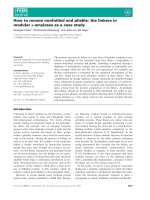
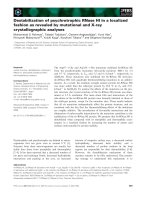
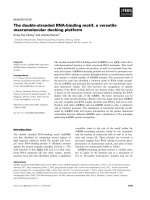
![Tài liệu Báo cáo khoa học: Expression of two [Fe]-hydrogenases in Chlamydomonas reinhardtii under anaerobic conditions doc](https://media.store123doc.com/images/document/14/br/hw/medium_hwm1392870031.jpg)
